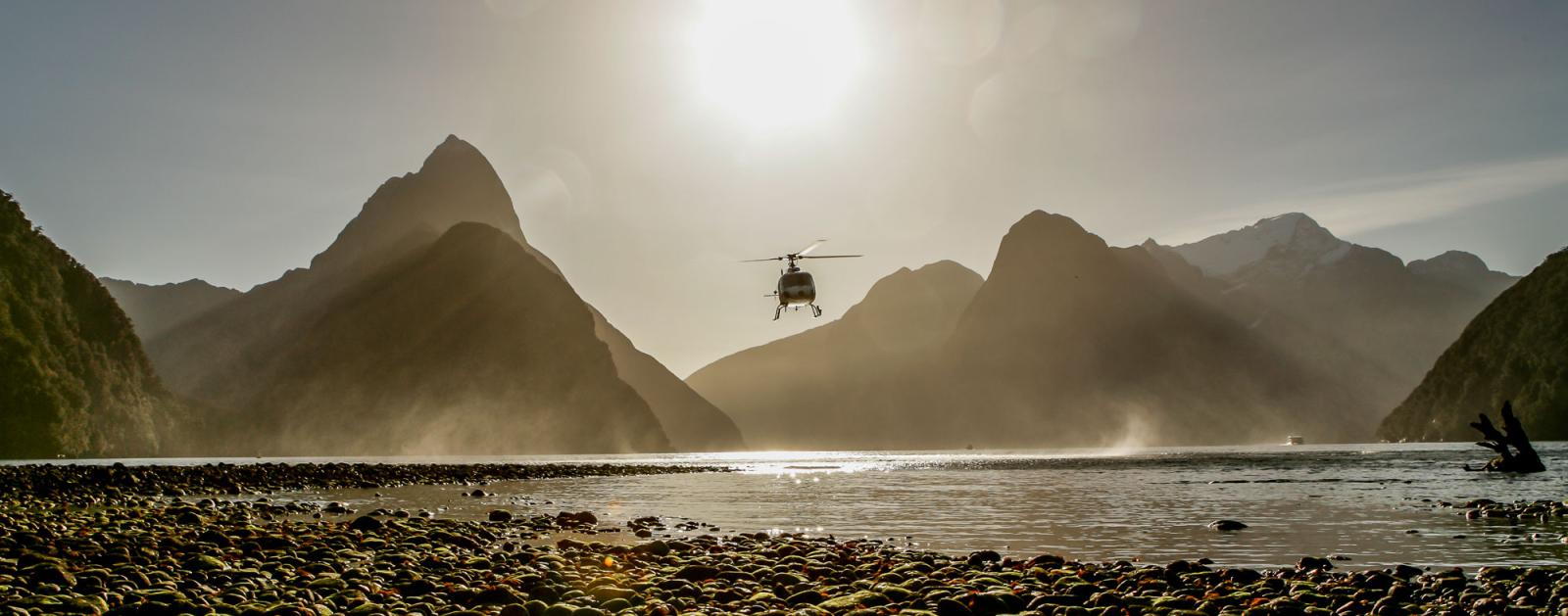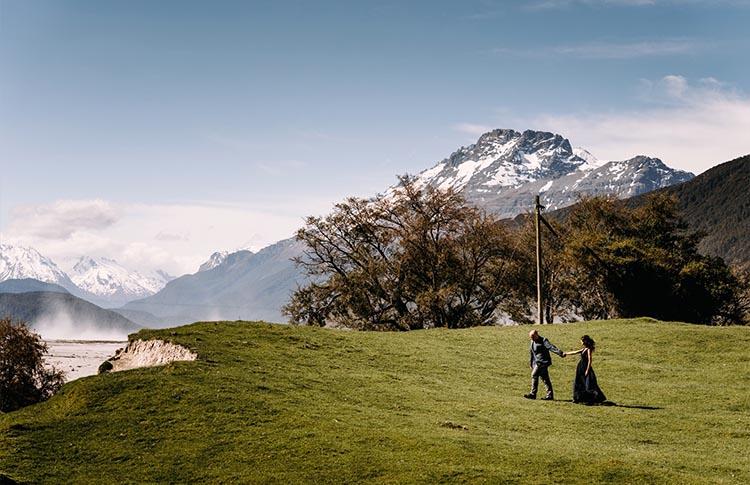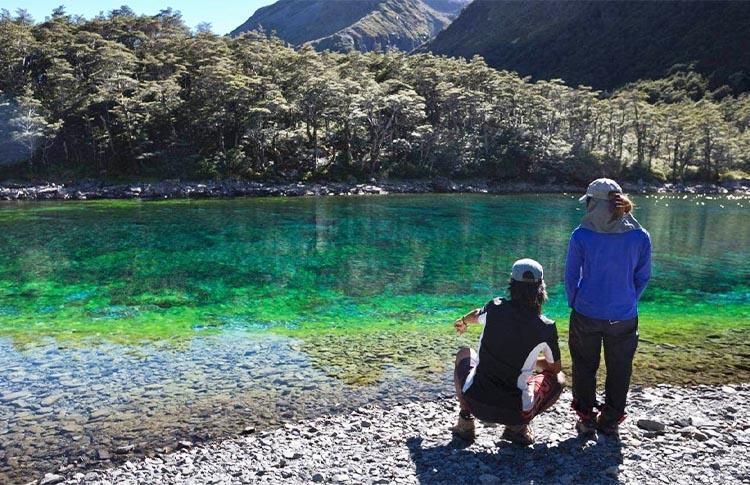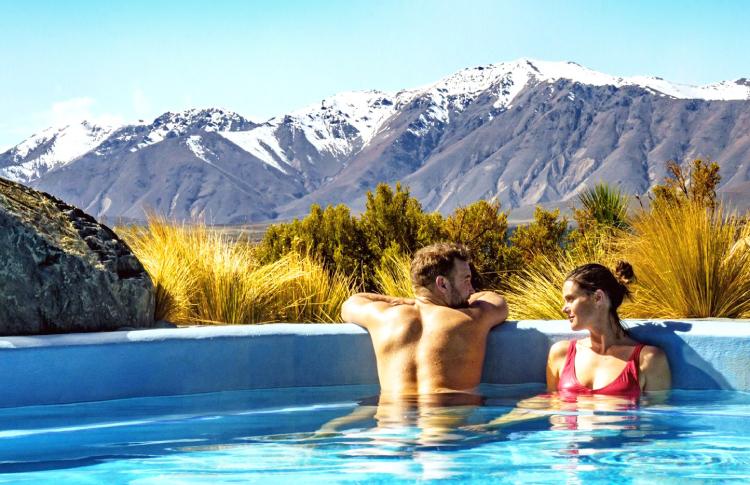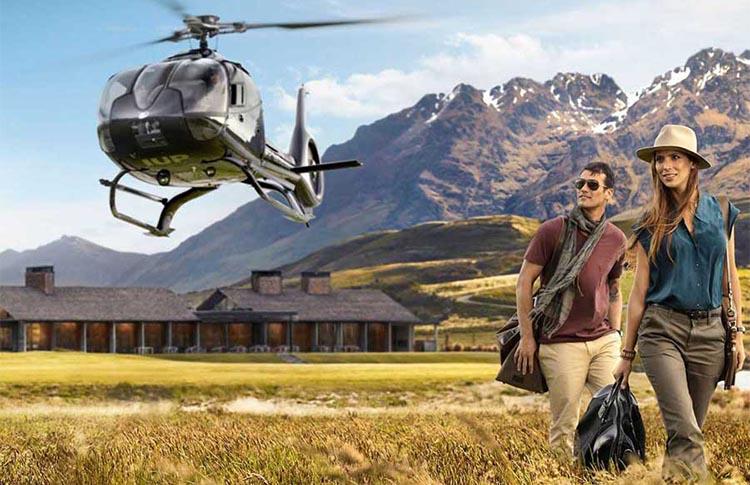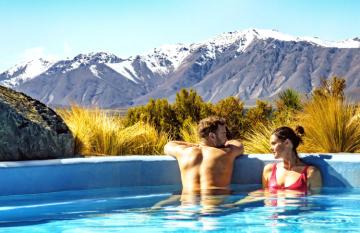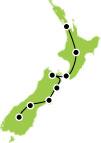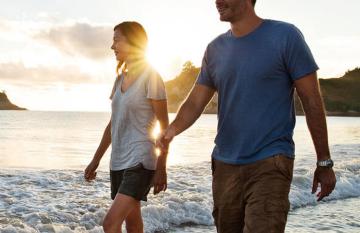
Wondering when to plan your New Zealand honeymoon? Find everything you need to know in this comprehensive guide to the best time for a New Zealand honeymoon.
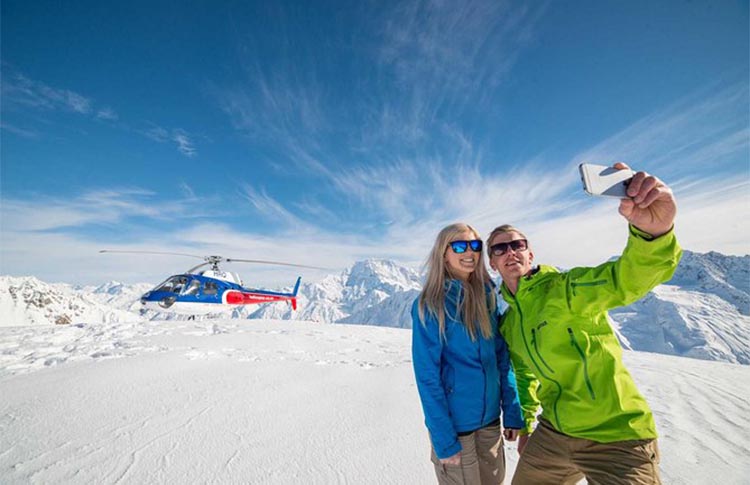
Contents
Best time for a New Zealand Honeymoon
If you like the idea of planning a honeymoon in New Zealand, but aren’t sure of the best time to do so, don’t worry. You’re in the right place!
From what weather to expect to which romantic photo locations to target, you can rest assured that you’ll have all the information you need. And the good news is, whatever time you plan to come, there’s really no bad time to book a New Zealand honeymoon!
When is the best time for a New Zealand honeymoon?
This question can be asked in two different ways:
When is generally the best time for a New Zealand honeymoon?
When is the best time for a New Zealand honeymoon FOR YOU?
Naturally, these two different questions will have different answers. It depends on where you want to go, what you want to do, and what you hope to get from your New Zealand honeymoon.
To start with, let’s take a look at what weather you can expect at different times of year.
Weather and climate for New Zealand honeymoons
New Zealand Seasons: A general outline for honeymooners
Summer (December-February)
Warm, dry days and long, sunny evenings are the norm around most of the country during summer. This is the busiest time of year for both tourists and locals, but with good reason – it’s the best time for hitting New Zealand’s many fabulous beaches, lakes and rivers.
Autumn/Fall (March-May)
A popular time for planning a New Zealand honeymoon, the “Shoulder Season” between summer and winter is one of the most beautiful times for enjoying New Zealand’s great outdoors (without the heat or the crowds) and seeing the landscapes change color.
Winter (June-August)
Cool and wet in some areas, dry and dark in others, winter is peak season for skiing, snowboarding, and spotting the Southern Lights. Winter is mild and even warm in the far north of the country, while temperatures regularly drop below freezing in the south and at altitude.
Spring (September-November)
Spring is a wonderful time for a New Zealand honeymoon, with temperatures rising and a busy time for seeing lots of New Zealand’s wildlife in action. It’s a wonderful time for hiking and cycling, before hotter temperatures and bigger crowds arrive in summer!
New Zealand Climate: A general outline, by location
Given its maritime climate, New Zealand doesn’t have extreme climatic differences compared with some countries. However, there are some distinct differences depending on where you go.
There are several factors to consider regarding New Zealand’s climate. Sometimes, simple factors hold true like “North = hotter” and “Higher = colder”. Sometimes, however, it isn’t quite that straightforward.
So, here are some general climatic factors to keep in mind when planning your New Zealand honeymoon:
North vs South
Generally speaking, the North Island is warmer and wetter than the South Island, while the South Island is typically cooler and drier than the North Island. On average, mean temperatures in the deep south are around 10°C (50°F), and 16°C (61°F) in the far north. However, this varies drastically from place to place, and from season to season.
Wellington, for example, at the bottom of the North Island, is generally cooler than the Marlborough and Tasman regions, at the top of the South Island. Also, although the subtropical north of the North Island gets lots of rain, the South Island’s West Coast is, by far, the wettest single region in New Zealand (and one of the wettest in the world). And although winter temperatures are lowest in the south and central South Island, during peak summer the hottest temperatures in the country are typically recorded in the South Island’s dry eastern plains.
Mountains vs Sea
New Zealand is a collection of islands, and it therefore typically has a mild, maritime climate. However, in some places it also shoots from sea level up to nearly 4,000 m (13,000 ft) in the space of barely 50 km (30 miles). So altitude can have a huge impact on weather, too.
Generally speaking, according to the National NZ Institute of Water and Atmospheric Research, temperatures drop about 0.7°C (1.3°F) for every 100 m (330 ft) of altitude. This is something to keep in mind if looking at areas like Queenstown, Tongariro, and Aoraki Mount Cook on your honeymoon itinerary.
East vs West
In terms of when to expect rainfall or sunny days, the question of whether you’re heading east or west is potentially the biggest factor to consider.
New Zealand’s prevailing winds, rain and weather come from the west, across the Tasman Strait. This gives the whole of New Zealand a clear distinction between wetter “Windward” districts (to the west) and drier, sunnier “Leeward” districts (to the east).
This is most extreme in areas where these winds and water come up against high mountains – most notably, the Fiordland region of the South Island’s West Coast is New Zealand’s wettest region, but Alexandra, less than 100 km (60 miles) away to the east, on the other side of the Southern Alps, is the driest. It’s similar in the North Island, with the eastern district of Hawke’s Bay regularly seeing the most sunshine hours in the country. The further north you go, especially in the Bay of Islands and Northland, this factor is less important, though, and the area is more defined by its subtropical latitude.
What are the sunniest and wettest times for a honeymoon in New Zealand?
In general, summer (Dec-Feb) is the driest and sunniest time of the year for most of New Zealand. This is especially so in the North Island, with key honeymoon regions like the Bay of Islands, Auckland, Wellington, Coromandel, Bay of Plenty and Northland having their driest and sunniest months between November and February, and their wettest months during winter (June-August).
In the South Island, however, winter is often the driest time of year for alpine regions (and prime honeymoon destinations!) like Queenstown and Aoraki Mt. Cook, and relatively low rainfall for coastal regions like Nelson/Abel Tasman National Park and, comparatively speaking, Milford Sound.
Sunshine hours are high throughout summer across the country, but become shorter the further south you go towards winter (due to latitude). Despite this, South Island regions like Marlborough and Tasman regularly have the highest average sunshine hours in the country, thanks to a low number of rainy and wet days throughout this time!
When are the busiest and quietest times for a New Zealand honeymoon?
Summer is the busiest time of the year for all of holidaymakers, honeymooners and locals in New Zealand, with the extended school summer holidays and Christmas/New Year break getting most kiwis out and about at this time. It’s a popular time for things like hiking, cycling, kayaking, fishing, surfing, bungee jumping, and just about anything else you can do – but rightly so! Beautiful sunshine, warm days, long evenings, and high temperatures make this a very pleasant time for New Zealand honeymoons, no matter where you go.
Winter (June-August) is the busiest time of year for skiing, snowboarding, stargazing and other fantastic honeymoon activities in New Zealand. This makes areas like Lake Tekapo, Mt. Cook, Queenstown, Lake Taupō and Tongariro/Mt. Ruapehu relatively busy throughout July, August and September. Conversely, this is the quietest time of year for holidaymakers in much of the North Island, which can provide honeymooners with a special opportunity to be even more alone in a cozy, romantic hideaway in the winter wilderness.
Following the end of summer, Fall/Autumn (March-May) brings beautiful colors to areas like Arrowtown and Central Otago, while temperatures still remain relatively mild across the country, and even warm in the far north. Similarly, during Spring (September-November), mild temperatures and lower rainfall combine with much smaller crowds to make this a wonderfully rewarding time to plan a honeymoon in New Zealand.
Which Seasons are the Most Expensive for a New Zealand honeymoon?
Most expensive: Summer and Winter (in some places)
Unsurprisingly, peak summer temperatures and tourist crowds make it the most expensive time all across New Zealand for things like flights, accommodation and activity bookings. This is particularly so around Christmas and early January, which is typically the most expensive time of year for New Zealand holidays and honeymoons. Winter is peak ski season in Queenstown and other alpine regions, which makes this an expensive and popular time to come compared with other months. That means things like activities and accommodation will fill up early, so be sure to book well in advance if you want to plan your New Zealand honeymoon during this time!
Cheapest: Spring and Fall/Autumn
Generally speaking, the cheapest times for a New Zealand honeymoon are during the “Shoulder Seasons” of Spring and Fall/Autumn. Winter, outside of the alpine regions, is also generally much cheaper. May is the cheapest single month for airfares to New Zealand and hotel bookings. But it’s also worth noting that some honeymoon highlight activities might shut down during winter and/or the quieter months – so be sure to check before you book!
When is the best time of year for New Zealand honeymoon activities?
Taking on a tandem skydive? Reciting recent wedding vows beneath a waterfall? Cuddling up under the UNESCO-protected starry night skies? Relaxing in an alpine onsen spa overlooking a snowy wilderness? If you’ve got your heart set on something in particular that will make your New Zealand honeymoon just that bit more special, then it’s good to know the best time to plan a New Zealand honeymoon in order to do it.
The best time of year for a New Zealand honeymoon if you want to:
Spot the Southern Lights
Winter & Fall/Autumn (March-September)
The dark, deep, long winter nights and clear skies give honeymooners the best chance of seeing the Aurora Australia (“Southern Lights”) in the night sky. With plentiful options of glass-domed accommodation and private secluded cabins combined with deep latitudes, areas like Aoraki Mt. Cook, Lake Tekapo, and Rakiura Stewart Island are the best spots to cuddle up and sleep under the stars on a New Zealand honeymoon.
See amazing waterfalls
Spring (September-November)
Seeing stunning waterfalls and soaking in thermal spas have regularly been listed as the highlights of New Zealand honeymoons by past honeymooners, and this is the best time of year to see them. With the onset of warmer temperatures and snowmelt from the mountains, plus higher rainfall coming out of winter in areas like Milford Sound, New Zealand’s many majestic waterfalls are at their biggest and best during this time.
Go skiing
Winter (June-September)
July and August are the most reliable months for skiing on a New Zealand honeymoon, with the assurance of plenty of snow, plus the famous apres-ski comforts of places like Queenstown and Taupō in full swing. Think romantic restful evenings by the fireside and soaks in alpine hot tubs. Depending on the year, the season can kick off as early as June and run all the way through September, too!
Go hiking
Spring (September-November) and Autumn/Fall (March-May)
With temperatures less intense than peak summer, but still mild or warm for most of the country, Spring and Autumn/Fall are a wonderful time to go hiking in New Zealand. Throw in the fact that these periods have much smaller crowds than during summer, and many honeymooners may just feel like they have an entire mountain or wilderness track all to themselves. How romantic.
Get some sun
Summer (December-February)
Summer vibes are in full flow in New Zealand leading up to Christmas and hit a peak around late January and February. The hottest time of year across the country, this is also the period when the North Island and its many amazing beaches have their lowest rainfall and highest amount of sunny days. If your perfect honeymoon looks like sharing some sun together and/or hiding away on your own private beach, then summer in New Zealand is hard to beat.
Basically, the idea of a “bad” time for a New Zealand honeymoon doesn’t really exist. Still, depending on what you’re looking for and what you want to do, it’s good to keep these things in mind.
Next steps: Start planning, find out more, or book now!
If you’re still unsure about when the best time for YOUR New Zealand honeymoon is, you can find a whole lot more information about visiting New Zealand on the First Light Travel website, including a blog dedicated to the Best Time to Visit New Zealand. You can also read reviews from other couples who have booked their NZ honeymoon through FLT over the past two decades.
First Light Travel have over 20 years experience in planning perfect New Zealand honeymoons, each one catered to each couple’s preferences. You can check out the different New Zealand honeymoon packages and self-drive tours they offer. But the easiest way to know the best time for your New Zealand honeymoon, and how to plan it, is to contact FLT’s New Zealand honeymoon experts directly. They will give you all the info you need and walk you through the entire process. Totally free of charge.
Recent Posts
Blog Categories
Blog archives
- February 2025 (3)
- January 2025 (6)
- December 2024 (12)
- November 2024 (3)
- October 2024 (2)
- July 2024 (2)
- May 2024 (12)
- April 2024 (2)
- March 2024 (2)
- January 2024 (2)
- November 2023 (10)
- October 2023 (4)
- August 2023 (1)
- May 2023 (2)
- April 2023 (2)
- March 2023 (17)
- February 2023 (4)
- January 2023 (4)
- December 2022 (11)
- November 2022 (7)
- October 2022 (1)
- May 2022 (1)
- March 2022 (3)
- February 2022 (3)
- January 2022 (1)
- December 2021 (1)
- August 2021 (1)
- June 2021 (1)
- May 2021 (2)
- February 2021 (1)
- August 2020 (1)
- July 2020 (1)
- May 2020 (1)
- April 2020 (1)
- March 2020 (1)
- January 2020 (1)
- December 2019 (1)
- November 2019 (1)
- October 2019 (1)
- September 2019 (1)
- August 2019 (5)
- July 2019 (2)
- June 2019 (1)
- May 2019 (3)
- April 2019 (1)
- March 2019 (1)
- February 2019 (1)
- January 2019 (1)
- December 2018 (1)
- November 2018 (1)
- September 2018 (1)
- August 2018 (1)
- July 2018 (1)
- June 2018 (1)
- May 2018 (1)
- April 2018 (1)
- March 2018 (1)
- February 2018 (1)
- January 2018 (1)
- December 2017 (1)
- October 2017 (1)
- September 2017 (1)
- August 2017 (1)
- July 2017 (1)
- June 2017 (1)
- May 2017 (1)
- April 2017 (1)
- March 2017 (1)
- February 2017 (1)
- January 2017 (1)
- December 2016 (1)
- November 2016 (1)
- October 2016 (1)
- September 2016 (1)
- August 2016 (1)
- July 2016 (1)
- June 2016 (1)
- May 2016 (1)
- April 2016 (1)
- March 2016 (1)
- February 2016 (1)
- January 2016 (1)
- December 2015 (1)
- November 2015 (1)
- October 2015 (1)
- September 2015 (1)
- August 2015 (1)
- July 2015 (1)
- June 2015 (1)
- May 2015 (1)
- April 2015 (1)
- March 2015 (1)
- February 2015 (1)
- January 2015 (1)
- December 2014 (1)
- November 2014 (1)
- October 2014 (1)
- September 2014 (1)
- July 2014 (1)
- June 2014 (3)
- May 2014 (1)
- April 2014 (1)
- March 2014 (1)
- February 2014 (1)
- January 2014 (1)
- November 2013 (15)
- October 2013 (1)
- September 2013 (1)
- August 2013 (1)
- July 2013 (1)
- May 2013 (1)
- April 2013 (1)
- March 2013 (1)
- February 2013 (1)
- January 2013 (1)
- December 2012 (1)
- November 2012 (2)
- October 2012 (2)
- September 2012 (2)
- August 2012 (2)
- July 2012 (2)
- June 2012 (2)
- May 2012 (2)
- April 2012 (3)
- March 2012 (2)
- February 2012 (2)
- January 2012 (3)
- December 2011 (1)
- November 2011 (1)
- October 2011 (2)
- September 2011 (1)
- August 2011 (1)
- July 2011 (1)
- June 2011 (1)
- May 2011 (1)
- April 2011 (1)
- March 2011 (1)
- February 2011 (1)
- January 2011 (1)
- December 2010 (1)
- November 2010 (1)
- October 2010 (1)
- September 2010 (1)
- August 2010 (1)
- July 2010 (1)
- June 2010 (1)
- May 2010 (1)
- March 2010 (1)
- February 2010 (1)
- January 2010 (1)
- December 2009 (1)
- November 2009 (1)
- October 2009 (1)
- September 2009 (1)
- August 2009 (1)
- July 2009 (1)
- June 2009 (1)
- May 2009 (1)
- April 2009 (1)
- March 2009 (1)
- February 2009 (1)
- January 2009 (1)
- December 2008 (1)
- May 2005 (1)

